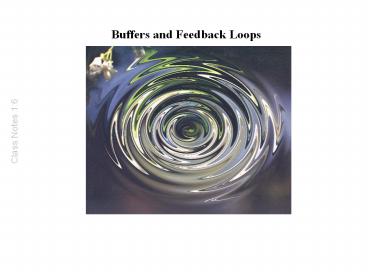Buffers and Feedback Loops - PowerPoint PPT Presentation
1 / 34
Title:
Buffers and Feedback Loops
Description:
A forest experiences less fluctuation. in temperature, wind, and ... Thus the microclimate in the forest is buffered against extremes. Less fluctuation. ... – PowerPoint PPT presentation
Number of Views:42
Avg rating:3.0/5.0
Title: Buffers and Feedback Loops
1
Buffers and Feedback Loops
Class Notes 16
2
Buffers and Feedback Loops
Buffersare agents or regulatory mechanisms
that reduce or minimize fluctuations and change
3
Buffers and Feedback Loops
Example
A forest experiences less fluctuation in
temperature, wind, and humidity than an
unforested area
Less fluctuation.. Less change
4
Because the trees cool with their shade, block
winds, and their fallen leaves help keep the soil
moist
Thus the microclimate in the forest is buffered
against extremes
Less fluctuation.. Less change
5
How Feedback Loops Function Example One
A feedback is a signal that can be detected and
can trigger a response
1
Imagine an air-conditioner regulated by a
thermostat
time
6
How Feedback Loops Function
As the room warms, the thermostat detects the
change, and causes the air-conditioner to switch
on
2
time
and in response, the temperature begins to fall
7
How Feedback Loops Function
As temperatures cool, the thermostat again
detects the change and shuts off
the air-conditioner
3
time
and, in response, the room begins to warm again
8
These repeated reversalsillustrate the
usefulness of negative feedbacks
4
time
Negative feedback loops help bring constancy to a
system and help buffer the system against
Extremes Fluctuations, and
Change
9
Negative feedback loops help bring constancy to a
system
time
Reducing
- Extremes
- Fluctuations
- and
- Change
10
They help produce and maintain an active
state of constancy known as.
Homeostasis
time
the tendency of a system, esp. the physiological
system of higher animals, to maintain internal
stability.
11
Some Feedback Loops Can Destabilize
12
What is the opposite of a negative feedback loop?
Answer A positive feedback loop
13
When a signal is detected in a positive feedback
system
The system responds by
- Amplifying
- Intensifying
- Magnifying
- or
- Accelerating
the original trend
14
This is what happens in chain reaction
explosions such as nuclear detonations
One atom splits and its fragments cause two or
more other atoms to split, and their fragments
cause many others to split
accelerating and intensifying the energy release
with each step
15
Magnifying or Intensifying an Original Trend
The effects of positive feedback loops
quite often are
not positive
16
Living systems tend to benefit
from Negative Feedback Loops
because the interactions of many species help
maintain
- Stability
- Constancy
- and
- Homeostasis
in the system
17
Buffers and Feedbacks on a Planetary Scale
18
Buffers and Feedbacks on a Planetary Scale
NASA consultant James Lovelock helps us see
buffers and negative feedback systems at work on
a planetary scale
19
First, envision an imaginary planet that is
perfectly round, smooth, grey and lifeless
He calls his imaginary planet "Daisyworld"
20
If Daisyworld'ssun heats up andemits more
radiation, what will happen to Daisyworld's
temperature?
The planetary temperature will increase
21
Decreased Solar Output
What will happen toDaisyworld's temperature if
its star becomes cooler and emits less radiation?
The planetary temperature will go down
22
Next imagine thatDaisyworld is inhabited by two
species of organisms
White daisies that reflect
light energy
23
And dark daisies that absorb
light energy
24
Imagine that 100 of Daisyworld's surface is
covered with equal numbers of these two species
25
Decreased Solar Output
What happens if Daisyworld's sun becomes cooler?
Will both daisy species be affected in the same
way?
26
Decreased Solar Output
The dark daisies are better able to survive a
decrease in solar radiation
because they absorb the energy that arrives
As a result, dark daisies increase in numbers
27
Decreased Solar Output
In contrast, the light daisies reflect thelight
that arrives and their numbers decline
28
With so many additional dark daisies absorbing
solar radiation,
Daisyworld remains warmer than it would be if it
were entirely lifeless
29
Increased Solar Output
What if Daisyworld's star heats up?
This time the dark daisies absorb too much of
theextra solar output
and their numbers decline
30
The light daisies, however, reflect much of the
excess heat so that they survive
and cover a greater portion of Daisyworld's
surface
31
Significance
The presence of life
( in this case, two mindless species of daisies)
- helps moderate planetary conditions
- helps reduce fluctuations and change
- buffers Daisyworlds temperature
32
Positive and Negative feedback loops in Global
Warming
Both negative and positive feedback processes
occur in the atmosphere. If negative feedback
loops are strong, then global warming will not
occur or be moderated. If positive feedback loops
prevail, global warming could be catastrophic for
life as we know it.
33
1. Increased algae populations reduce CO2 in
atmosphere and causes cooling.
3. Increased water evaporation will increase
cloud cover and cause cooling.
2. Increased plant growth will reduce CO2 in
atmosphere and causes cooling.
The Negative Feedback loop
34
4. Increased evaporation adds more water vapor to
atmosphere causing warming
5. Melting of permafrost releases more methane
gas causing warming
6. Reduced summer snow-pack decreases Earths
albedo causing warming
7. Increased use of air conditioning using more
fossil fuels causes warming
The Positive Feedback Loop

